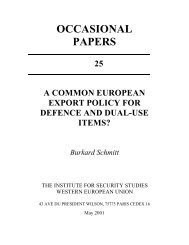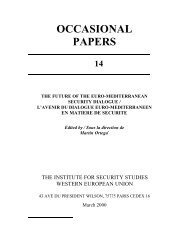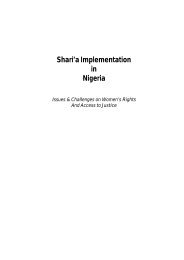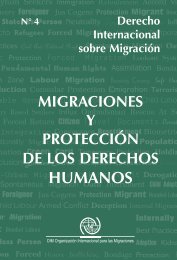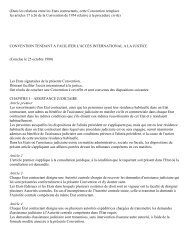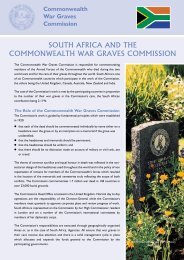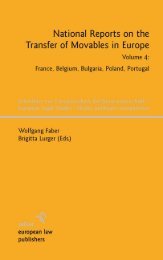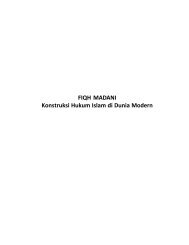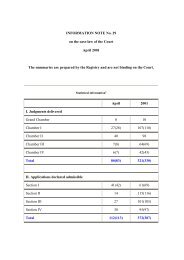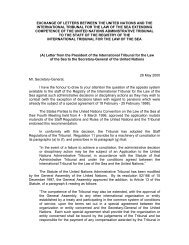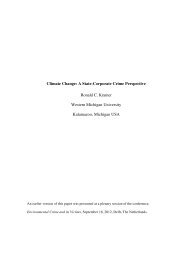Party Autonomy in International Property Law - Peace Palace Library
Party Autonomy in International Property Law - Peace Palace Library
Party Autonomy in International Property Law - Peace Palace Library
Create successful ePaper yourself
Turn your PDF publications into a flip-book with our unique Google optimized e-Paper software.
3. The Numerus Clausus and <strong>Party</strong> <strong>Autonomy</strong> <strong>in</strong> the <strong>Law</strong> of <strong>Property</strong><br />
were the rights treated <strong>in</strong> the code, and that all other rights were personal<br />
only. The early drafts were superseded by codes modelled on the French<br />
Code civil. A provision <strong>in</strong> the old Dutch Burgerlijk Wetboek of 1838 conta<strong>in</strong>ed<br />
a non-exhaustive catalogue of real rights, similar to Article 543 of<br />
the French Code civil and equally <strong>in</strong>adequate as a statutory foundation for<br />
a numerus clausus of property rights. Consequently, 19 th century Dutch<br />
courts were <strong>in</strong>cl<strong>in</strong>ed to grant parties considerable liberty to devise new<br />
types of property rights outside the scope of the old Burgerlijk Wetboek.<br />
The numerus clausus received a warmer reception <strong>in</strong> 19 th century Dutch<br />
doctr<strong>in</strong>e than <strong>in</strong> the courts. The works of both Diephuis 18 (1817-1892)<br />
and Opzoomer 19 (1821-1892), two monumental 19 th century legal scholars<br />
<strong>in</strong> the Netherlands, show a clear tendency to adhere to a strict <strong>in</strong>terpretation<br />
of the old Burgerlijk Wetboek; the statutory provisions were their ma<strong>in</strong><br />
focal po<strong>in</strong>t when describ<strong>in</strong>g and analys<strong>in</strong>g the limits of the law of property.<br />
Tell<strong>in</strong>g are a number of references <strong>in</strong> the work of Diephuis to the French<br />
author Demolombe (1804-1887). 20 Where French courts and doctr<strong>in</strong>e of<br />
that period predom<strong>in</strong>antly favoured a large role for party autonomy <strong>in</strong> the<br />
field of property law, Demolombe argued extensively for adherence to the<br />
types of property rights chosen and regulated by the French legislature.<br />
The l<strong>in</strong>e taken by Diephuis and Opzoomer became so deeply entrenched<br />
<strong>in</strong> Dutch legal th<strong>in</strong>k<strong>in</strong>g that opposition was too little and too late for the<br />
numerus clausus to be rejected. As mentioned above, <strong>in</strong> 1905 the Hoge<br />
Raad cemented the foundations of the numerus clausus <strong>in</strong> Dutch law.<br />
It can be concluded that the numerus clausus, as the expression of the will<br />
of the legislature, has been part of Dutch legal th<strong>in</strong>k<strong>in</strong>g s<strong>in</strong>ce the era of<br />
codification <strong>in</strong> the early decades of the 19 th century. However, the works<br />
of Savigny and the Pandectists fleshed out this pr<strong>in</strong>ciple, result<strong>in</strong>g <strong>in</strong> what<br />
is now understood as the numerus clausus and the closed system <strong>in</strong> the law<br />
18<br />
G. Diephuis, Het Nederlandsch Burgerlijk Regt naar de volgorde van het<br />
Burgerlijk Wetboek, volume III, 1846 (1st edition) & 1857 (2nd edition); G.<br />
Diephuis, Het Nederlandsch Burgerlijk Regt, volume VI, 1880 (1st edition)<br />
& 1886 (2nd edition).<br />
19<br />
C.W. Opzoomer, Het Burgerlijke Wetboek verklaard, Volume III, Art. 555-<br />
783, 1871; C.W. Opzoomer, Het Burgerlijke Wetboek – Aanteeken<strong>in</strong>g op de<br />
artikelen die thans nog verklar<strong>in</strong>g behoeven, Volume II, 1850.<br />
20<br />
C. Demolombe, Cours de Code Napoléon, band IX, De la dist<strong>in</strong>ction des biens;<br />
de la propriété; de l’usufruit, de l’usage et de l’habitation, 1854, nrs. 462-532,<br />
p. 351-470.<br />
T.H.D. Struycken 65<br />
© sellier. european law publishers<br />
www.sellier.de



